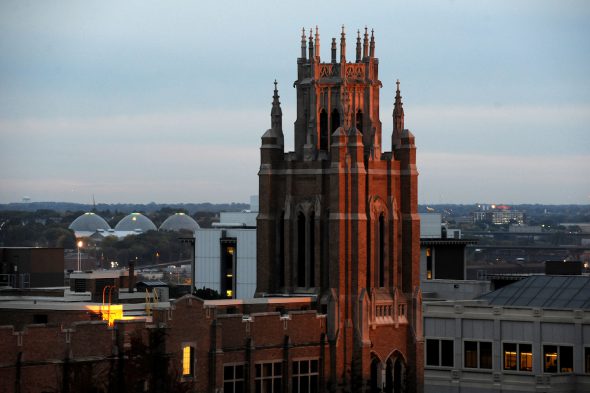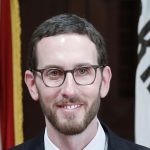Marquette University Cuts Reflect National Trend
A decline in commitment to liberal arts seen in Wisconsin and nationally.

Marquette Hall. Photo courtesy of Marquette University.
This spring, Marquette University did not renew contracts of dozens of non-tenured and visiting professors mostly in the humanities or liberal arts. Justification for the cuts were based upon declining enrollment because of the pandemic and a smaller pool of prospective students due to declining birth rates.
The Examiner has previously outlined how Nathan Grawe sent shockwaves through higher education in his 2018 book, Demographics and the Demand for Higher Education, in which he asserted that a dramatic drop in enrollment was coming due to declining birth rates. But the book only served as the latest major jolt. Other authors had sent other charges into higher education such as Thomas Frey who stated in 2013 that as many as 50% of all colleges and universities could collapse by 2030.
After the recent staff cuts, the local chapter of the American Association of University Professors (AAUP) has raised funds to conduct an independent audit of Marquette’s finances using publicly available documents. The university administration is not cooperating with the audit. Howard Bunsis of Eastern Michigan University will conduct the audit to be completed by Fall 2021.
Marquette is not alone
Much before that, on May 27, 2020, Marian University in Fond du Lac declared an “enrollment emergency” slashing programs and suspending much of the faculty handbook. Nine programs would be gone mostly in arts and music; nine tenured or tenured-track faculty members would be terminated.
The administration stated they had no alternative other than shutting down, and “We have no intention of closing the University.” The present enrollment decline is due to the COVID-19 pandemic, but the university had been losing money for years according a report conducted by AAUP.
Ironically Marian was just welcoming students from another Catholic university that closed, Holy Family in Manitowoc, just over 50 miles away.
The AAUP report outlines a total of eight universities around the country all in similar situations. Because AAUP sees itself as a labor union for professors, much of its report focuses on the loss of professor tenure, unilateral rewrites of the institutions’ handbooks by the administrations and a lack of shared governance. Embedded in the discussion is the gutting of humanities and liberal arts.
The report highlights another Jesuit institution like Marquette, Canisius College in Buffalo, N.Y. It shows the extent to which some colleges and universities see the impact of dropping enrollment and what compromises they are willing to make.
In 2012-2013, Canisius had nearly 5000 students. “We are now around 2000 students,” a 60% drop in 8 years, says Tanya Loughead, professor of philosophy at Canisius and president of the local chapter of AAUP. She is also author of the 2015 book, Critical University: Moving Higher Education Forward.
Canisius slashed humanities programs. Says Loughead, “Our college fired our one and only Shakespeare expert.”
The cuts to the humanities are of particular concern to Loughead in terms of Catholic Jesuit identity at Canisius. Although there are cuts to other humanities departments, the theology and philosophy departments have cut their tenured positions from eight to four positions in each department. It has a big impact on the college’s identity.
“What does it mean to be a Jesuit school? Increasingly, nothing,” says Loughead, “The more we become like every other school, and cut our famous commitment to the humanities and asking the big questions of life, in the humanities, in philosophy and theology, the more we become just like every other school, and our administrators show they have no commitment to social justice, the more we become indistinguishable from every other university.”
Private schools are not alone
In May 2018, the Progressive Magazine shouted out the headline, “Oh the Humanities! Wisconsinites Fight Efforts to Kill Off University Majors.” Atlantic Magazine declared in December “The Liberal Arts May Not Survive the 21st Century,” zeroing in on abandonment of the “Wisconsin Idea,” a belief that the university system should benefit all.
This was the reaction to UW-Stevens Point announcing in March 2018 that it would eliminate 13 majors, all in the humanities and liberal arts including such programs as English, history, philosophy, political science, sociology, arts and foreign languages. Cuts were to fill the hole in a $4.5 million structural deficit — and this was before the pandemic. At the same time, the university wanted to increase “growth programs” such as environmental engineering and business.
Contributing factors cited were a state-imposed tuition freeze, cuts in state funding and a declining pool of prospective students. The school had already increased workloads and class sizes, reduced administration and suspended upgrades in equipment, technology and facilities.
State Rep. Katrina Shankland (D-Stevens Point) states she and the university began to hear from community members, local elected officials, faculty, students and alumni.
Unlike private colleges and universities, public institutions are much more sensitive to the political forces around them. Even a loss of a handful of programs and majors and the downsizing of a campus can mean the loss of hundreds of jobs and millions of dollars to a community.
In the end, UW-Stevens Point backed down. Mick Veum, chair of physics, told Inside Higher Ed that the proposal may have been pulled “because there were enough people leaving ‘voluntarily’ to make the nuclear option unnecessary (period).”
Consolidation to UW campuses may have saved some money. But Shankland isn’t so sure. UW-Stevens Point was consolidated with two-year campuses: Marshfield-Wood County and Marathon County, both running deficits larger than the St. Point campus. The same type of consolidation took place across Wisconsin with other 4-year campuses having local 2-year programs placed under their wings.
Why humanities and liberal arts matter
Universities’ presidents and boards of directors state that, in order to survive, they must react to market forces. This is particularly true of small colleges with marginal endowments and precarious enrollments — give students what they want, especially when tuition keeps climbing. That means practical, “money making” degrees such as engineering, business, health fields and the like.
Shankland isn’t so sure these institutions are on the right track. “What I hear from employers is, ‘We need somebody who can write. Do you know anyone with an English degree?’” But it goes beyond just advancing in a career. Shankland believes in “the value of humanities in our society… the need for everyone to be well-rounded, critical thinkers, flexible and adaptive.”
Universities cutting humanities are not thinking ahead. Shankland contends these ideas are “outdated notions or stereotypes.” She is not alone.
Edward J. Maloney is an English professor and executive director of the Center for New Designs in Learning and Scholarship at another Jesuit institution, Georgetown University. He is coauthor with Joshua Kim of the book, Learning Innovation and the Future of Higher Education. They state that we need to look differently at the role of higher education; we need to take teaching and learning more seriously and look at new ways to educate.
However, Maloney believes that some students may no longer think it is worth the expense to go to a college that holds these other values. Instead, they may look for a six-month boot camp that will give the skills to land a high paying job now. But skills needed in the future will surely change.
Maloney is frustrated: “Most college boards are made up by people who are in business, not by educators, people who are giving a lot of money… to sit on their boards.” Too often they are short-term thinkers.
Both Maloney and Kim point to Joseph E. Auon, president of Northeastern University in Boston and author of Robot-Proof.
Alternatives to cuts
Auon puts forth the proposition that many of the aspects of what we think of as necessary skills in such areas as engineering, business and even medicine are rapidly being replaced by robots, machines and computer programs. Preparing graduates with narrowly tailored programs may doom them to obsolescence unless graduates apply what they know, how to learn, think critically and creatively. Key to fostering these attributes is a liberal arts education.
Northeastern University has created 115 cross-departmental majors, many incorporating humanities with other, more highly paid professional fields. Consider majors such as Economics and Philosophy, Architecture and English, Data Science and Psychology. Not all combined majors are paired with a practical field and humanities, but are designed to get students out of their comfort zone. And if a student wants to create a different combination, that can be done as well.
Today Northeastern is flooded with applications and running a budget surplus despite the COVID-19 shutdown. That was not the case 15 years ago.
In 1996, Richard Freeland became president of Northeastern, a university on the ropes with falling enrollment, budget cuts and staff layoffs. Northeastern’s turnaround was based on a single focus of the criteria U.S. News and World Report uses in its college rankings. If the magazine gave points for the percentage of classes with under 20 students, Northeastern made sure most classes would have less than 20 students; 19 students would be the norm. Freeland reverse engineered the magazine’s rating to determine what was being evaluated but not shared with the institutions.
Northeastern began to rise in the U.S. News rankings and that paid off in increased applications. The university has been criticized for “gaming” the system. But it must be noted that most actions Northeastern took actually improved the university. At least this was better than looking for deeper cuts.
Today university president Auon knows how Northeastern got where it is, but he is less focused on the basic rankings. Its present situation allows him to focus on what is important in education.
While Northeastern’s actions were partly a public relations campaign, Loughead says the lack of a quality PR campaign at Canisius has been a major contributing factor to her university’s decline. Loughead says that the Canisius administration will point to the declining prospective student populations in upstate New York, but she states that neighboring Catholic institutions such as Niagara and Bonaventure have held their own even though they are ranked no better than Canisius.
Universities must show the value of humanities and liberal arts to incoming students. Recently, the Strada Institute for Future of Work analyzed 100 million social and professional profiles and resumes and more than 36 million job postings.
“There are those who believe that the ‘hard’ skills of science, technology, engineering, and math (STEM) are most critical to the future, and those who believe the uniquely ‘human’ skills of the liberal arts are the ones that will endure in the face of automation.” The report concluded both things are true. Colleges must learn to bridge the gap between liberal arts and the workforce.
Nathan Grawe, who started the latest scramble to find solutions to declining enrollment, takes on the issue in his new book, The Agile College: How Institutions Successfully Navigate Demographic Changes. He gives little credit to the humanities cuts going on at universities across the country as a solution. He believes that if these same institutions would just concentrate on maintaining their current student populations, cutting the dropout rate by 25%, many colleges would have far fewer problems with enrollment. That means a lot more mentoring and listening to student needs. Universities should look at expanding offerings for less traditional students, expanding online courses, night and weekend classes. If the university offers daycare to the children of college students, the center can’t just close its doors at 6 p.m. because of evening classes.
Most colleges and universities will probably say they are doing most of these things, but it has to be more than just checking the boxes; it requires serious commitment.
A year ago, Carthage College in Kenosha, Wis. announced it was cutting 23 professors and eliminating the classics department as well as philosophy and great ideas. Other departments were considered for elimination, all in the humanities, but were ultimately saved. Other colleges and universities across the state and the nation are cutting such programs, often just quietly downsizing existing departments, replacing tenured professors with part-time or temporary instructors, all in an effort to balance budgets.
To what degree these actions are necessary or misguided is still being debated. In the end, the bigger question is whether our college graduates will be well educated or just well trained. Will they be ready for the future?
Marquette University cuts and the decline of liberal arts was originally published by the Wisconsin Examiner.





















Marquette was founded with the intention of providing an affordable education to Milwaukee’s growing German immigrant community, and it’s had a remarkable rise since then.